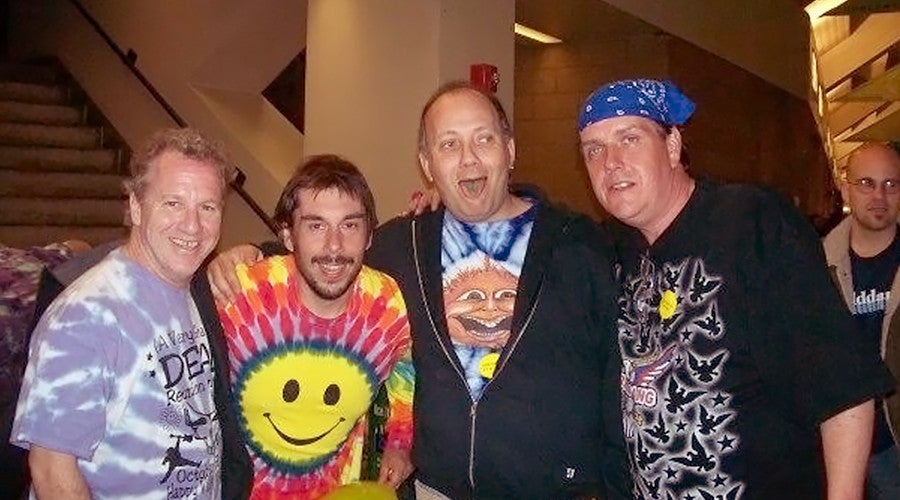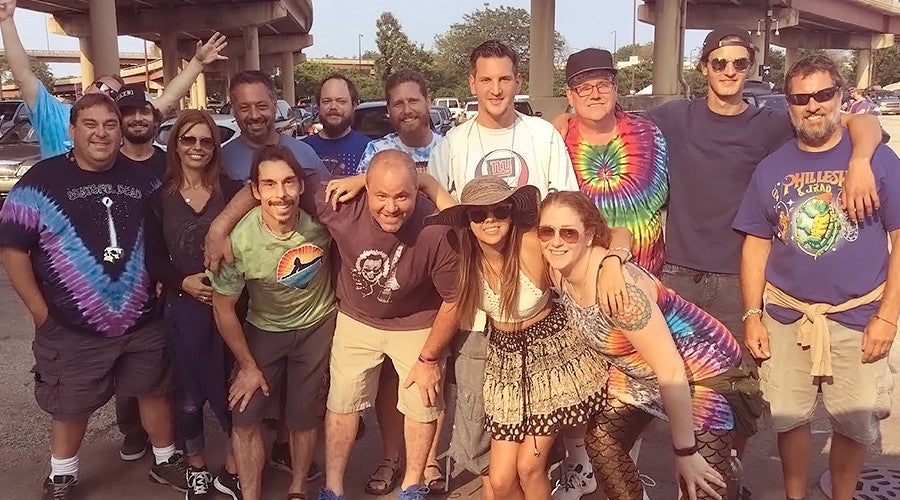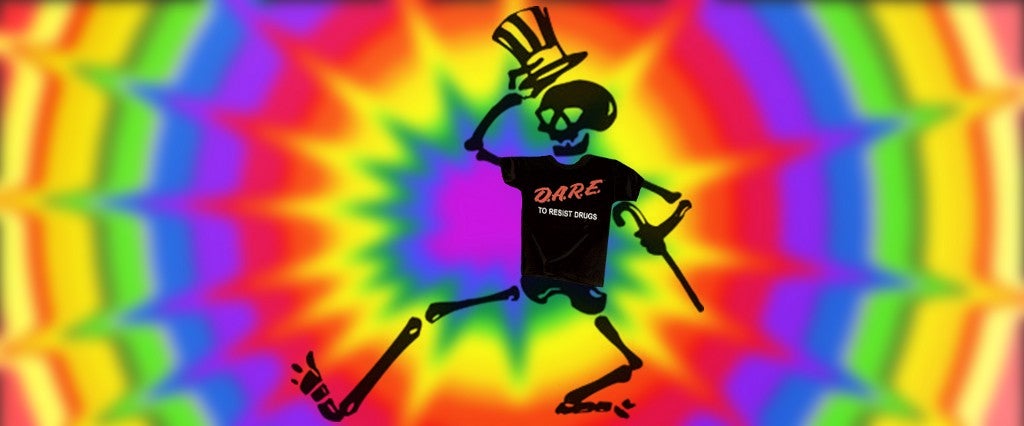“JUST ANOTHER DOPELESS HOPE FIEND” read the yellow sticker affixed to Mike McHugh’s tie-dyed Grateful Dead tee.
McHugh was the last kind of person I expected to meet at the band’s trio of farewell concerts this past July in Chicago, though in many ways he was the quintessential fan. He first discovered the band during a 1982 bong session at Tufts University. Whoever was controlling the stereo had on the Dead’s famed Europe ’72 live recording, prompting McHugh to ask, “What is this music?” Two weeks later, he was at his first live Dead show, and he’d go on to see them another 350 times. Now, here he was at Soldier Field: a pot-bellied, white-collared, middle-age dad out to relive his rock ‘n’ roll youth.
But McHugh was also member of the Wharf Rats, a substance abuse recovery group for (and by) a subsect of sober Deadheads. He was there to rock, but not roll.
To an outsider, sobriety seems an affront to the Dead’s very existence. Perhaps no other band in the sordid history of rock ‘n’ roll is as closely associated with drug culture than the Dead. Born of mid-‘60s psychedelia and remaining comfortably in that aesthetic ever since, the Dead are often perceived as the consummate drug band, and for good reason.
A nascent version of the Dead called The Warlocks served as the house band for the Merry Pranksters, the Ken Kesey-led revolutionaries whose gospel was blotter acid and free sex. Jerry Garcia, the band’s emotional and musical center, did enough acid to earn him the nickname “Captain Trips.” When the Dead appeared in the inaugural issue of Rolling Stone in November 1967, it wasn’t for a story about their music — it was about the drug raid conducted on the band’s San Francisco home a month earlier. Narcotics agents seized more than a pound of marijuana and arrested 11 in the bust, and the group responded not with denials, but by extolling the virtues of weed.

But the band’s light-hearted relationship with drugs darkened over time. Ron “Pigpen” McKernan, the band’s founding members, joined rock’s infamous 27 Club after drinking himself to death in 1973. Phil Lesh had to get a new liver in 1998. Three years earlier, Garcia died of a heart attack while trying to kick his heroin and alcohol addictions. Garcia was such a junkie toward the end of his career that he’d frequently nod off onstage, forgetting lyrics and botching riffs.
And that was just the band.
Deadheads have long been considered some of the most notorious partiers on the planet, and many of them believe you can’t fully appreciate the Dead unless you’re tripping your balls off. The parking lot outside each Dead show is home to a lawless, open-air bazaar called Shakedown Street. There, enterprising hippies sell an array of homemade Dead merchandise, and, more importantly, drugs.
The corresponding images of a Deadhead are aging free spirits whose faculties have diminished from too many years on the road; young, trustafarian gutterpunks; beer-guzzling Phish bros who latched onto the Dead scene because Fuck it. A party’s a party.
Either way, most are assumed to be unrepentant drug addicts.
Founded in the 1980s, the Wharf Rats takes its name from the Dead song, a bass-heavy blues ballad in which the narrator encounters a blind, homeless wino named August West begging by the docks. As with many Dead songs, “Wharf Rat” was never included on a studio album and can only be heard on the band’s concert recordings. Nonetheless, its third verse makes for a solid recovery mantra:
But I’ll get back on my feet again someday,
The good Lord willin’, if He says I may.
I know that the life I’m livin’s no good,
I’ll get a new start, live the life I should.
Although the Wharf Rats have no formal affiliation with Alcoholics or Narcotics Anonymous, they’re widely recognized as a much-needed substance abuse support group amid the buffet of temptations at the show: Everything from craft beers and fine wine tents to fans looking to trade you a handful of acid tabs for a ticket. In every direction, someone’s getting stoned.
The Dead’s farewell concerts were filled with displays of camaraderie between friends and strangers — I witnessed an older Dead fan gift a pair of tickets to a young couple who looked like they’d been wearing the same clothes for months — but none were as joyous and heart-warming as watching about 100 Wharf Rats meet up around a folding table during the intermission of the first show. They beamed, hugged, held hands. They raised their arms to the sky as the group leader led them in the Serenity Prayer.
It wasn’t until I settled back into my seat and saw McHugh wearing one of the Wharf Rats’ signature yellow stickers that I realized he had been among the blissfully sober scrum. A week later he recounted his long, strange trip into addiction, and it was every bit as harrowing as the Wharf Rats meeting was uplifting.
McHugh turned into a whitebread suburban dad Deadhead like many of his era. He was earning more than $100,000 a year as an IT specialist, living in Queens with his wife and four kids, but his addiction slowly overwhelmed his professional ambitions. If he went to work at all, he’d get high in the parking lot. Most days he’d just stay home and smoke weed — a weekly ounce at his peak, which cost about $1,600 per month. Unable to hold down a nine-to-five office job, he eventually found himself earning $47.50 a day as a day laborer on construction sites. He was soon forced to move to Hackensack, New Jersey, where he got by selling weed and hitting up his mom for frequent loans (taken from her retirement account).
In June 2008, his wife left him for an Englishman she met on MySpace, and his “rock bottom” came six months later, on January 20, 2009 (the day Obama was inaugurated). Police raided his home, found 15 grams of pot and arrested him for possession with the intent to sell. His three biological children were placed in foster care, and his stepson was sent to live with his biological father in Boston.
McHugh’s been sober ever since. After his mom bailed him out, he started outpatient rehab and Narcotics Anonymous that February. But it wasn’t enough to retain custody of his three kids. McHugh was able to secure a job at Cablevision, but knew he wouldn’t be able to provide for them on his modest $35,000 salary. Seeing his children were flourishing at their foster home in the New Jersey suburbs, McHugh decided to cede custody to their foster parents.
“I cried a lot over that decision, but I didn’t do something stupid like go get high. And because I stayed clean through that whole time, I kept a relationship with the foster parents and have a role in my children’s lives,” McHugh tells me.
Prior to treatment, weed was an integral part of McHugh’s Grateful Dead experience. He’d typically smoke four joints per set. He consumed acid fewer than 10 times and mushrooms no more than 20 — nearly all of which took place at Dead shows. “So I can’t argue with someone that if you do acid at a Dead show, you’ll have a great experience,” he jokes.

By pure, ass-backwards kismet, the first person McHugh spoke to at his first NA meeting also happened to be a Deadhead. They attended the Dead’s April 28, 2009 concert together at Izod Center in The Meadowlands — McHugh’s first since getting clean. It was there he attended his first Wharf Rats meeting, and he’s been an active member ever since.
Just two rows in front of me sits a man who is having the kind of Dead experience McHugh used to enjoy. On the first night of the three concerts, he dropped a tab of acid before smoking at least six joints over the course of the show. The second day he brandished a 2.5 foot tall bong and gleefully smoked it at his seat (a testament to the generally lax security at Dead shows).
Some Deadheads distance themselves from such unabashed drug use, saying they’re “just here for the music.” But that’s only half true. Deadheads show up to be around each other and bond over their shared love for guitar noodling and Dancing bears kitsch.
So, sure, for some that involves doing a bunch of drugs together. But for the Wharf Rats, it means helping each other stay off them.
